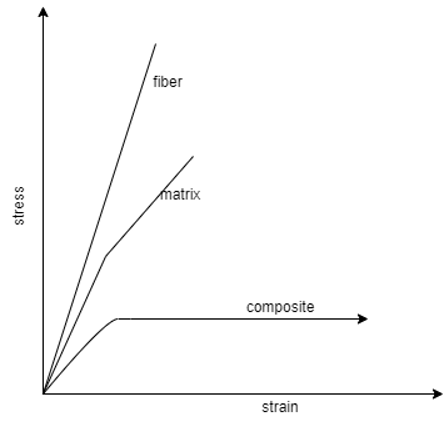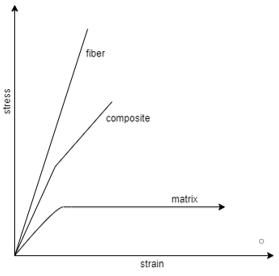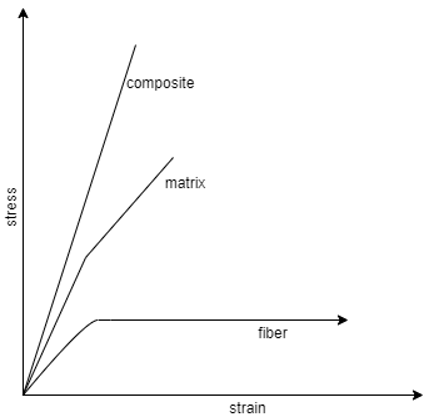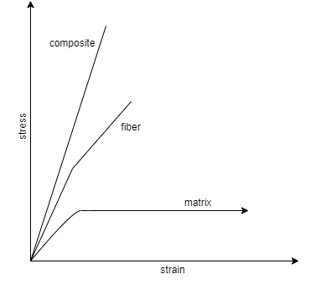This set of Composite Materials Multiple Choice Questions & Answers (MCQs) focuses on “Metal Matrix Composites – Set 2”.
1. What happens with the decrease in reinforcement particle size?
a) Yield strength decreases
b) Ductility increases
c) Tensile strength decreases
d) Ductility remains constant
View Answer
Explanation: The tensile and yield strengths increase as the reinforcement particle size decreases. The ductility also increases with a decrease in particle size, however, when the particle reaches a certain limit the ductility is observed to be decreasing to lower values.
2. Which method is used for the manufacturing of continuously reinforced MMC?
a) Liquid metal infiltration
b) Vacuum hot pressing
c) Compocasting
d) Powder metallurgy
View Answer
Explanation: The most common method used for the manufacturing of continuous fiber-reinforced MMCs is Vacuum hot pressing. In this process, the layup which is set up by drum winding is placed between the preheated plates of a hydraulic press until the temperature and vacuum level of the layup reaches the preset value. After that, the hydraulic plate pressure is raised for a time period for the completion of the consolidation of layers into the required thickness.
3. The consolidation of layers in Vacuum hot press takes place through diffusion bonding.
a) True
b) False
View Answer
Explanation: The consolidation of layers also takes place through plastic deformation and creep of the metal matrix. The quality of the consolidation is controlled by various parameters like temperature, pressure, holding time and cleanliness of layers to be joined.
4. The tensile modulus of the composites decreases with increasing reinforcement volume fraction.
a) True
b) False
View Answer
Explanation: The tensile modulus increases with the increase in reinforcement volume fraction. But, the increase in non-linear. The experimental values of modulus are much lower than the theoretically determined values.
5. Which process uses atomized metal powders for the manufacturing of discontinuously reinforced MMC?
a) Liquid metal infiltration
b) Compocasting
c) Squeeze casting
d) Powder metallurgy
View Answer
Explanation: In powder metallurgy, atomized metal particles are blended with declustered particulates. or whiskers. The declustering involves stirring of the liquid suspension of reinforcement in an ultrasonic bath and this blended mixture is compacted in a die and is vacuum hot pressed to form a cylinder structure. After the temperature is raised above the solidus temperature of the matrix alloy, the pressure is applied in the hot press for forming the discontinuously reinforced MMC.
6. Which among these doesn’t help in improving the wettability of metal over fiber surface?
a) Controlling chemical environment
b) Adding an alloying element
c) Coating the reinforcement surface
d) Decreasing fiber surface tension
View Answer
Explanation: The wettability can be improved by controlling the oxygen content in the environment which prevents the formation of the oxide layers in the surface of the metal. The addition of an alloying element also helps in disrupting oxide layer formation. Moreover, unwanted chemical reactions can also be prevented by coating the reinforcement surface with suitable coatings.
7. Which process is known as a modified rheocasting process?
a) Compocasting
b) Squeeze casting
c) Vacuum hot pressing
d) Liquid infiltration
View Answer
Explanation: Rheocasting is a process of casting slurry by vigorously stirring a liquid metal during solidification. The slurry thus formed can be mixed with short fibers, particulates and whiskers before casting. The developed form of rheocasting for the production of near-net-shape MMC structures is compocasting.
8. In compocasting, good bonding is achieved by increasing the mixing time and reducing the slurry viscosity.
a) True
b) False
View Answer
Explanation: The slurry viscosity can be decreased by increasing the slurry temperature as well as the shear rate. The increase in the mixing time enables longer duration of interaction between the matrix and the reinforcement.
9. Which casting process involves solidification of liquid metal under pressure?
a) Powder metallurgy
b) Squeeze casting
c) Vacuum hot pressing
d) Pultrusion
View Answer
Explanation: Squeeze casting is a net-shape casting process. High pressure is maintained throughout solidification in the squeeze casting process. This helps in the formation of equiaxed fine grain structure and minimizing defects like porosity in the casting. These characteristics give much greater tensile strength as well as higher strain to failure than other manufacturing methods.
10. Which of the diagrams represent the longitudinal tensile stress-strain relationship of a unidirectional continuous fiber-reinforced MMC?
a) 
b) 
c) 
d) 
View Answer
Explanation: When the matrix reaches its yield strain, it begins to deform plastically and the fiber remains elastic. But, the composite, after reaching the yield strain point begins to deviate from its initial slope and exhibits a new longitudinal modulus.
Sanfoundry Global Education & Learning Series – Composite Materials.
To practice all areas of Composite Materials, here is complete set of 1000+ Multiple Choice Questions and Answers.
If you find a mistake in question / option / answer, kindly take a screenshot and email to [email protected]
